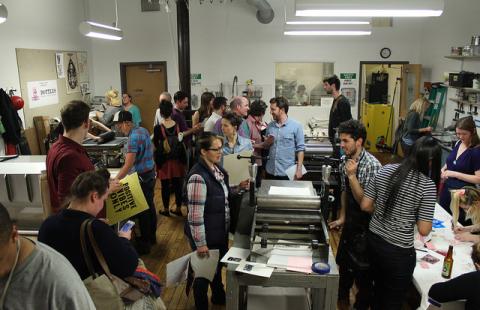What were the specific goals of this creative economy project? Describe the community development challenge or opportunity that your project was designed to address:
To create a space and community that both provides training in the techniques as well as access to the tools required for printmaking. The community structure of the Printshop mitigates the large capital investments required to create a successful print business, while also providing in-house feedback and support. Outside of student-only university facilities, these resources are not readily available in the community, short of temporary journeyman roles that might be available at a previously established print businesses.
If the goals change over time, please describe how:
Fundamentally the goals mentioned above have remained the same over time. We have widened the scope of our goals to focus more on aspects of social justice and expanding our user base to be more inclusive of young people and communities of color. The main strategy in achieving this goal is through AS220’s own Youth Program. AS220’s Youth Studios focuses on teaching skills and providing a supportive and creative environment for formerly incarcerated young people. Encouraging feelings of entrepreneurship through printmaking fits extremely well into the mission of both projects. Building personal relationships that foster trust and a sense of ownership in young people using the space takes time.
Who was involved in this project and what did they do? (be sure to include the partners from outside of the creative sector and how local voices were included):
Project partners are vast and diverse, from individuals interested in printing as possible income to institutions such as RISD & Brown. The Key Members and daily Shop Member users are considered the main partners in the project. After three months as a Shop Member, some members upgrade to Key Membership out of a desire to be more involved in the Industries community, daily operations, and decision-making. We receive sponsorship from Bottles Fine Wine for quarterly events held in the Printshop that introduce attendees to the equipment and space, but generally non-creative partners provide financial support through for-hire projects.
How does this project relate to a larger community development strategy?
The project connects to AS220’s larger strategy of creating open and unjuried spaces for individual artistic expression. Building community is at the core of AS220. Over 60 artists live in AS220’s buildings and 80% of these units are affordable housing. Creating space for artists to live also creates a need for direct access tools and knowledge. The Printshop’s Key Member program also gives artists round the clock access to to create work anytime, contributing to 24 hour vibrancy in downtown Providence. In addition, the project is connected to the larger strategy of the city of Providence in its branding as the Creative Capital. Printmaking is an extremely visible and democratic art form. Prints made at AS220 can be seen in windows on practically every block of the downtown Providence and in other neighborhoods of the city.
What projects or places, if any, inspired your approach to this creative economy project?
The Printshop as a program took its underlying mission from AS220’s larger unjuried/uncensored mission. The shop as a creative economy project takes specific inspiration from the lineage of printshops acting as community centers used for the productions of goods and the dissemination of information. Founded in 1973, Los Angeles’ Self Help Graphics, for example, is a print-based arts organization that has resonated specifically with our shift toward better supporting young people and people of color. Self Help Graphics was founded on the idea that printmaking is a democratic art form that lends itself to giving visibility and voice to those that are otherwise not heard. Their vision is “to be the pre-eminent center for Latino art in printmaking, exhibition and training, and to be a resource for young and emerging artists”
